

Marketing is really important.
It’s an obvious statement but did you know 72% of industry marketers said the importance of marketing in their organizations increased since February 2020—pressuring digital transformation? Marketers continue to push forward quality content amid all the noise.
But more importantly, their product/service makes a positive difference in consumers’ lives.
The marketing request dial is turning, increasing the amount of content creation and opportunities for companies. One destructive result of this increase is something that’s not talked about openly enough (and honestly) in the workplace: We are struggling. Like, a lot. 😮💨
Unclear goals, broken marketing workflows, and awkward communication cues could be avoided if we prioritized a better marketing project management process.
Whether you’re a freelancer or part of an in-house marketing department, there’s a possibility you’re overworked and under pressure to get deliverables across a finish line that keeps moving farther away.
In this guide, we’ll cover the ins and outs of marketing project management and how to create the best systems for your team and collaborators.
- What is Marketing Project Management?
- Key Differences Between Waterfall and Agile in the Marketing Project Management Process
- 9 Steps to Healthy and Successful Marketing Projects
- How Modern Marketing Teams Use Project Management Software
- Must-Have ClickUp Features for Every Marketing Organization Type
- Optimize Your Marketing Efforts With ClickUp
What is Marketing Project Management?
Marketing project management is a specialized function that focuses on planning, executing, and controlling marketing initiatives and campaigns. It covers the process of effectively coordinating and leading all marketing-related activities to achieve specific goals and objectives within the allocated time, budget, and resources.
For project managers, marketing project management involves overseeing the entire lifecycle of marketing projects, from ideation and strategy development to implementation, monitoring, and evaluation. Key responsibilities include:
- Project planning: Defining the project scope, objectives, and deliverables in alignment with the marketing strategy in a detailed project plan
- Resource management: Applying the right marketing talents, tools, and technologies available to execute the project successfully. This includes coordinating with various teams, such as creative, content, design, and digital marketing
- Budget control: Managing the project budget and expenses to maximize the return on investment while adhering to financial constraints
- Cross-functional collaboration: Facilitating collaboration and communication between marketing teams and other departments for seamless integration and alignment with overall organizational goals
- Risk management: Identifying potential risks and developing contingency plans to mitigate their impact on the project’s progress and outcomes
- Timely execution: Monitoring project progress, identifying potential bottlenecks, and proactively addressing issues to ensure timely delivery of marketing campaigns
- Quality assurance: Implementing measures to maintain the quality and effectiveness of marketing activities, ensuring they meet predefined standards and objectives
- Performance measurement: Defining relevant key performance indicators (KPIs) to evaluate the success of marketing projects. Analyzing marketing data and providing insights to enhance future marketing efforts
- Stakeholder management: Use stakeholder management software to engage with stakeholders, including clients, marketing teams, senior management, and external partners, to keep them informed about project progress and answer questions
- Continuous improvement: Conducting post-project reviews to identify lessons learned and areas for improvement in future marketing initiatives
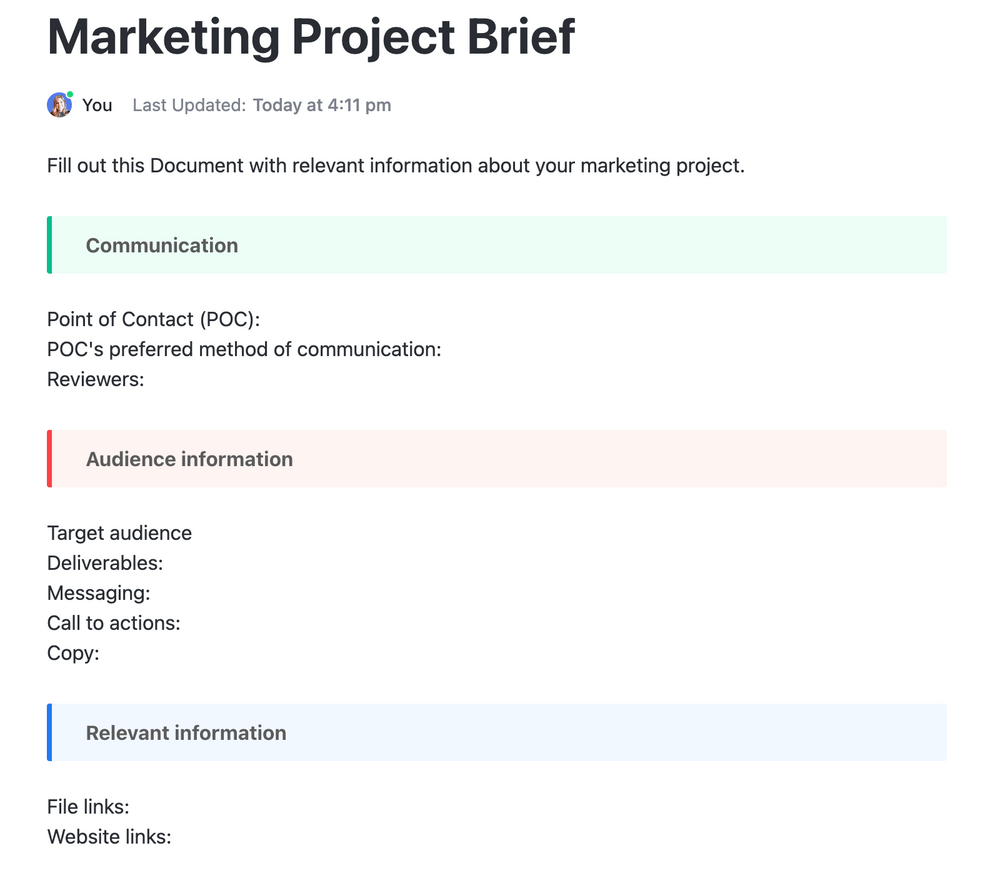
Key Differences Between Waterfall and Agile in the Marketing Project Management Process
Let’s explore two notable marketing project management methodologies: waterfall and agile.
This isn’t to persuade that one method is better because not all projects are suitable for agile, and not all projects are suitable for waterfall. Some projects could be predictable and routine, while others are risky and elaborate. If you carefully consider the project size and complexity, you will save time and money.

What is waterfall marketing? 🤔
Waterfall marketing is predictable
The waterfall method is a strict and linear process. Tasks are interdependent and carried out sequentially. The logical flow starts at the top and moves toward the bottom, achieving critical phases along the way. In waterfall, a phase cannot begin until the one before is complete.
Waterfall method characteristics:
- High levels of project governance
- Careful planning for each step so nothing is left to chance
- Comprehensive documentation
- Stakeholder and user expectations are supported by detailed planning and documentation
- Clear audit trail for knowledge management
Waterfall method red flags:
- Less room for error
- Changes are problematic and expensive
- Difficult to forecast
- Potentially lengthy timelines
Is agile project management a wild card then? Not necessarily.
Agile marketing adapts to changes
Unlike the waterfall method that locks in requirements and tasks in advance, agile marketing favors responding to changes over what it says in the project plan.
There are two popular frameworks of agile marketing: scrum and Kanban.
- Scrum: the scrum framework is purposeful for speed, with project lengths lasting from one week to four weeks. Closely-knit marketing teams are assigned easily consumable, actionable tasks during a sprint—a short, time-boxed interval to complete a set amount of work
- Kanban: alternatively, the Kanban framework centers around workflow visualization. On a Kanban board, task cards are dragged from one status column to the next. It’s loosely structured and enables continuous improvement without massive change
It’s worth mentioning that the agile method requires an added level of development training so teams are successful. Becoming an agile marketing organization involves a transformation effort to be fast in response times and reduce risks. There will be project disruptions if there’s no time for getting teams (especially remote teams) trained to understand scope and workflow.
9 Steps to Healthy and Successful Marketing Projects
Planning for the future is exciting but also stressful. You won’t see results if a marketing strategy doesn’t back up your marketing plan. 📈
The marketing plan is the roadmap of tactical steps to execute the strategy. It describes what, when, and how you will implement the strategy.
The marketing strategy is the why behind an organization’s marketing efforts and how the marketing goals will achieve the business goals. The four Ps of marketing concept:
- Product: What you sell (digital or physical products/services)
- Price: How much you charge and the impact of how prospects and customers view your brand
- Place: Where you promote your product/service for ideal customers to find information about you and your industry
- Promotion: What strategies you use for customers to find out about you
Bonus: Marketing Tools for Small Businesses
Before you assign tasks to the first available graphic designer, do you have a deep understanding of the challenge you’re solving, how you’re going to get there, and the target audience? The campaign budget?
We’ll take this one step at a time! Here’s how to plan for healthy and successful marketing projects. ✨
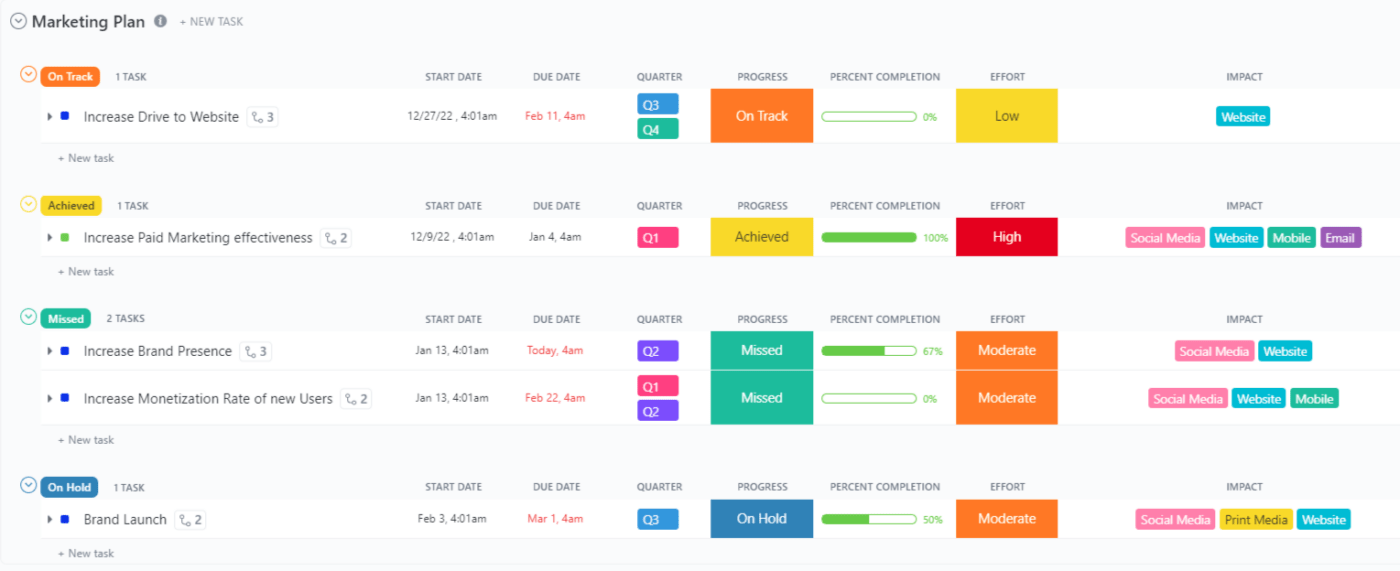
Step 1: Outline deliverables, required resources, timelines, budgets, KPIs (Key Performance Indicators)
Here’s the scenario: you are a marketing project manager tasked with leading a campaign launch to build brand awareness. Your project scope would include:
- Project Goals: achieve a 30% increase in brand lift metrics (KPIs)
- Project Deliverables: 15 educational video reels about the product, 30 seconds to a minute long each; distributed on Instagram, driving traffic to product landing pages
- Project Resources: content, creative, and social teams; marketing project management software
- Project Timeline: Final creative assets due by October 1, launch campaign October 8
- Project Budget: $10,000 (for video software, any contractors needed)
Step 2: Collect data and input from stakeholders and teams
Speak to stakeholders or partners working on the project to collect input and important information needed to complete a task. Don’t wait until after your graphic designers have turned over assets to mention something new!
As a marketing project manager, it’s not expected to know off the cuff how long it takes each team member to execute their deliverables. Get estimates on how much time and effort they’re forecasting to get the work done. They’ll address issues or conflicts that could comprise the timeline, which is valuable for managing projects.
Step 3: Include research
Research is the crux of every marketing project. Is there any existing research that could apply to this project? Will the social team need any tasks to conduct any new research? Following the project scope example we used above, this is necessary information for productive project conversations.
👉 One sec—if you need help organizing your project plans or task lists, check out ClickUp’s Template Center for campaign tracking, budgets, deliverables lists, and more!
Step 4: Assemble tasks and milestones
At this point, you have the project scope, stakeholder input, and research. It’s time to assign tasks using your marketing project management software.
Remember the time estimates you collected earlier? Be sure to include them in the tasks so team members can see their daily workload and adjust if they are over-allocated. Their workweek should be both manageable and realistic.

Step 5: Prep the team
It’s essential to hold a kickoff meeting to hear any questions or concerns directly from the teams after they’ve had a chance to assess their tasks. It’s also a great opportunity to remove any burdens the team could be feeling right away.
After the meeting, send a recap of key discussion points and takeaways. If any team members have action items, assign them right away so nothing falls through the cracks.
👉 Check out how Toyin Olasenhinde, a product manager uses the assigned comments feature in ClickUp when action items don’t warrant an entire task!
Step 6: Perform team check-ins and reviews
Schedule check-ins and reviews on the marketing calendar. As a marketing project manager, you should be aware of the team and project health. The frequency of check-ins and reviews depends on the project timeline and team capacity.
👉 Managing a virtual team? Learn seven ways to boost your virtual team communication strategy here!
Step 7: Track progress with a project dashboard
Dashboards are used by stakeholders, clients, and the project team to monitor progress. Stakeholders and clients need a high-level overview while the project team needs detailed dashboards that break down chunks of work.
If your marketing project management software has a dashboard feature, tap into the tool so you have different versions of a project dashboard made for each audience. Instead of going directly to you for updates, they’ll view the project dashboard first!
👉 Learn how to create powerful Dashboards in ClickUp with an easy step-by-step tutorial!
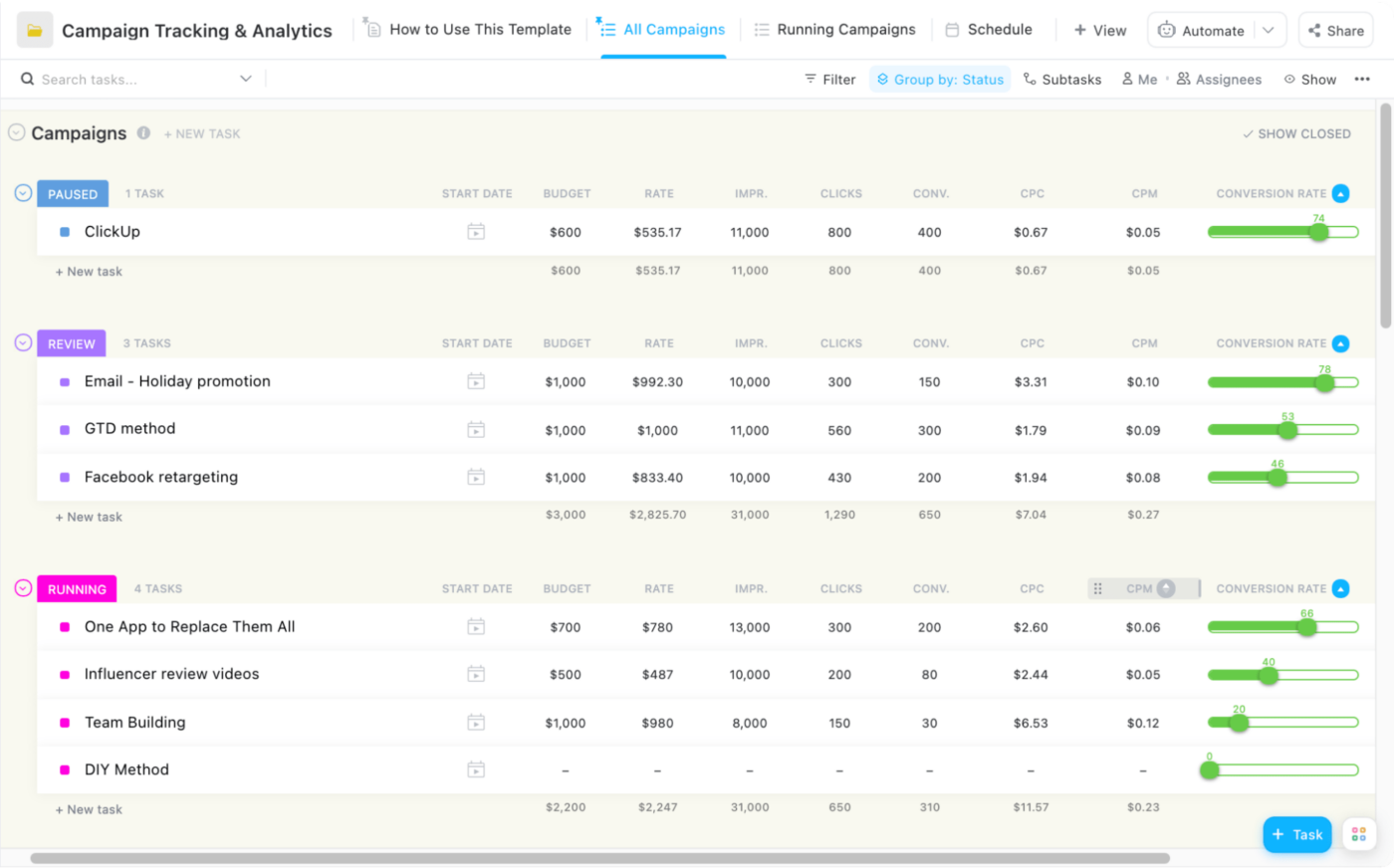
Step 8: Close the digital paperwork in the project management tool
Ring the bell! You and the team have crushed the project goals, so it’s time to let everyone know and review the end product. Ensure the final deliverables are wrapped in a virtual bow, lingering files are archived or deleted, and all open tasks are closed out in the project management tool.
Step 9: Reflect on the project journey as a team
This step is often overlooked because a new marketing campaign is on the horizon or teams have stepped out to recoup and recharge. Reflecting right away on a project’s wins and inaccuracies is a great learning opportunity for marketing project managers to fix processes for future marketing related projects.
If your team members are not comfortable going on a call to reflect on the project (or if there’s simply not enough time), the easiest way to collect this data is to send a digital form.
Here are questions to consider when organizing your form:
- If you could change a part of the process, what would it be?
- Did our marketing analysis identify the deliverable components we had to create at the beginning?
- Is our project management tool helping or hindering your productivity?
- What was the single frustrating event?
- Were you supplied with the information and resources to carry out your tasks?
- What was the most satisfying part of the project?
- Did the check-ins and reviews hurt or help your workflow?
- Are you proud of your finished deliverables?

How Modern Marketing Teams Use Project Management Software
Each marketing team has a different goal, role, and strategic value within the overall business.
Before you make a commitment to a marketing campaign request, get to know what information, resources, and project tools each marketing team needs to be successful. Add good communication, quick decision-making, and clearly-defined goals…and you’re gold! 🌟
Search Engine Optimization
SEO professionals are consistently implementing strategies and facilitating SEO workflows to complete deliverables. Backlink building, increasing organic traffic, and keyword research tasks on top of data insights sound like a recipe for overwhelm. They use interactive dashboards with real-time data. Consistent and automated reporting guards their time. As a result, efforts are spent in prioritizing ranking improvements!
Design
Graphic designers are approached by internal departments to lend their expertise (and sometimes blessing) to strengthen an asset’s design and messaging. A simple yet powerful project management feature to save time and inbox space is a digital request form.
Digital request forms remove the guesswork and back and forth between the graphic designer and requestor. By asking the right questions and requiring context to a request, graphic designers can focus their time and energy on actual work.

Editorial and Content Marketing
Content professionals are in the trenches with every marketing role. They are often accidental project managers” in concurrent campaigns and one-off requests. A typical affair they tend to find themselves in is spending large amounts of time on administrative tasks.
👉 Watch how ClickUp’s Content team automates current manual processes to maximize productivity here.
Must-Have ClickUp Features for Every Marketing Organization Type
ClickUp is a free project management solution that allows every team to manage projects, collaborate smarter, and bring all their work under one tool. Whether you’re new to project management apps or a total power user, ClickUp’s customization can stretch to any team size—remote or in-office—for the best productivity of your life.
We understand (and love!) that your team has different types of skill sets, personalities, and workflows. So in ClickUp, each member can customize their views and tasks however they need to while simultaneously working towards the same project goals as everyone else.
Here are ClickUp features for every type of marketing organization:
Team collaboration features for a marketing agency
- Guest permissions for team collaboration with your contractors and external clients
- Marketing project templates in the ClickUp Template Center for simplifying workflows
- Email in ClickUp to switch between sending a comment to internal teammates and sending an email to anyone outside of your Workspace

Task management features for an in-house marketing team
- ClickUp Views to look at projects, tasks, subtasks, and their unique characteristics in a meaningful way
- ClickUp Dashboards to view data and activities next to ClickUp Goals across all teams
- Time estimates and time tracking for resource allocation and billing
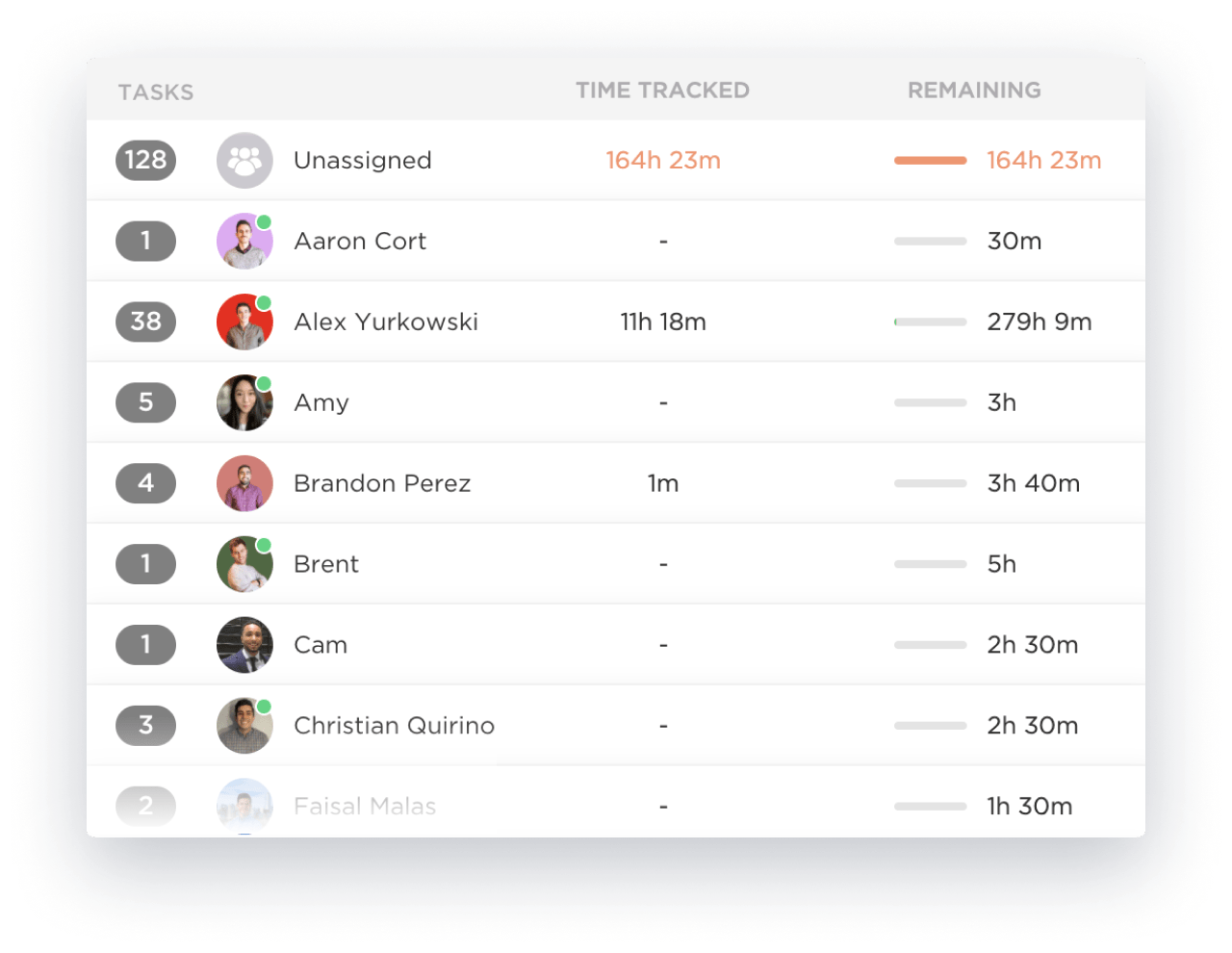
Time management features for freelancers and solopreneurs
- ClickUp Automations for client and team onboarding, assigning tasks, updating statuses, and more
- Time Tracking in ClickUp to categorize time spent on specific tasks and track billable hours
- ClickUp Recurring Tasks to set repeating schedules and administrative tasks
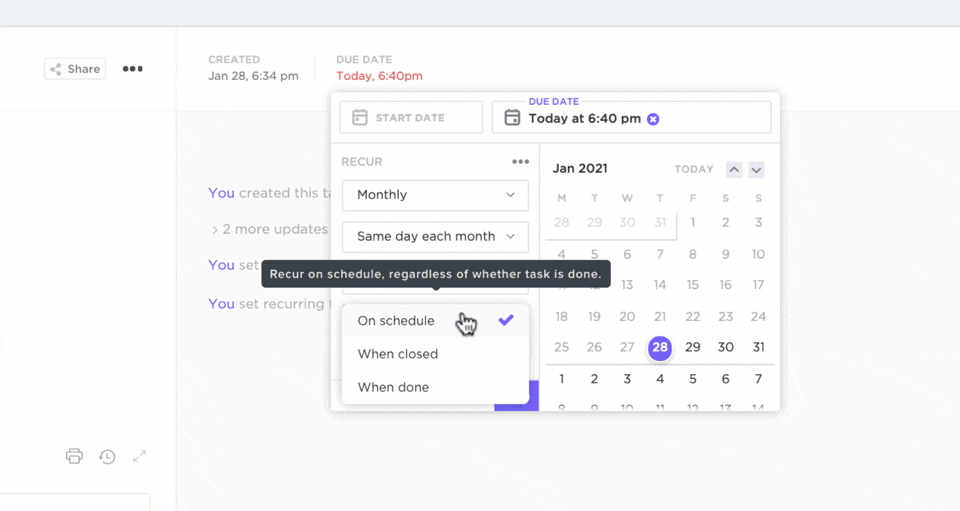
Optimize Your Marketing Efforts With ClickUp
“Job burnout is a special type of work-related stress—a state of physical or emotional exhaustion that also involves a sense of reduced accomplishment and loss of personal identity,” according to the Mayo Clinic.
What if we recognize that we could carry out our campaigns and product launches without compromising team health? Change starts by getting our marketing project management system clear. 💎
Honestly, we get that you’re up against time (and maybe even leadership buy-in) to put in the work and improve your team’s project management process. If you feel a responsibility to yourself and your team to make things better, you are not alone!
That’s why ClickUp has free, 24/7 support via email, phone, and online chat to help with organizing your Workspace and setting up your team for success.
Get started in ClickUp and soon you’ll have stand-ups that will be the highlight of everyone’s day! ☀️





